#MEAN Stack Web Development Solutions
Explore tagged Tumblr posts
Text
In the realm of MEAN stack development, effective data modeling is paramount to the success of applications. MongoDB, as the NoSQL database component of the MEAN stack (MongoDB, Express.js, AngularJS, Node.js), offers flexibility and scalability in managing data. Mastering the art of designing MongoDB schemas is essential for Mean Stack Application developers to create robust and efficient MEAN stack solutions. Let's explore the intricacies of MEAN stack data modeling and unveil the strategies for crafting MongoDB schemas that drive optimal performance.
#ahextechnologies#Mean Stack Application developers#MEAN Stack Solution#MEAN web development services#MongoDB development services#Mean Stack development
0 notes
Text
Full Stack Development Made Simple: Expert Tips from Thelma Ivuka Onwukwe

Thelma Ivuka Onwukwe, a full stack development expert, explains that full stack development means working on both the front end (what users see) and the back end (how the website or app works behind the scenes). A full stack developer can build a complete website or application from start to finish, including designing web pages, writing code, connecting to databases, and making sure everything runs smoothly. This role requires knowledge of many tools and programming languages like HTML, CSS, JavaScript for the front end, and Python, Node.js, or PHP for the back end. Thelma Ivuka Onwukwe says being a full stack developer is useful because it allows one person to understand the entire system, solve problems quickly, and build better, faster, and more efficient digital solutions.
2 notes
·
View notes
Text
latest Freddie DeBoer seems odd. It's very focused on a sort of consumer-facing understanding of technology for a lot of its runtime. He's not wrong that the changes are smaller than they were in the 1800's but like. That's the low hanging fruit, we all know this, the jump from "not having trains" to "having trains" beats almost any improvement in "trains"
A major change technology has brought to the modern world imo is heavily streamlined manufacturing all across the industrial stack.
If you read like, Bunie Huang's Made in China blog series, in the early 2000's getting a piece of technology made required enormous in-person investment of time and effort working with your manufacturing teams across a pretty broad number of suppliers and industries, you had to get PCB's made, components sourced, moulds designed and set up for injection.
I know people manufacturing small to medium run commercial and industrial electronics, and I did that at my last job. You order machine populated PCB's from your favourite Chinese PCB solutions provider over a web form. If you need ten thousand buttons, you can get that delivered with three emails. Hell, if you want a custom genome to use for some experimental bioreactor, there's multiple competing suppliers who will mail you plasmids that you can customise from online templates and you don't even have to talk to anyone.
And that's just mass manufacturing. If you're making a few thousand of some high end medical equipment, or still in the development phase of design, you can order a titanium laser print to be delivered by the end of the week, or run off a dozen prototypes on your company's fleet of printers using body safe plastics.
Consumer needs don't change much because people are people, we have limited capacity to need things and do things. I've long said that no human can digest more than 50Mbps of media in real time, really. One home cook can only economise their movements so much. A food processor and a pressure cooker can save you some time but the solution to"I want to spend less time cooking at home" will eventually become "don't cook at home, lean on industrial manufacturing of food" and that's fine. There's only so much tech can improve your individual experience before you become the bottleneck.
Faster computers sure, means you can edit video on your phone a little quicker (also hey people ARE editing video on their phone, despite what this blog post says) but it also means Netflix can serve their 4 Petabytes of video library at 400+Gbps from a single server occupying less than 50 liters of space.
It seems disingenuous to act like consumer products feeling stagnant means technology is stagnant.
21 notes
·
View notes
Text
Transforming Businesses with DI Solutions: Innovative IT Expertise
Transform your business with DI Solutions

In the ever-evolving digital landscape, businesses must harness cutting-edge technology to remain competitive. At DI Solutions, we specialize in driving business transformation through advanced IT solutions and expert services. Our dedication to innovation and excellence has empowered numerous clients to achieve their goals and excel in their industries.
Innovative IT Solutions DI Solutions excels in providing tailored IT solutions that meet each client's unique needs. Our services include custom software development, mobile app creation, web development, and UI/UX design. By leveraging the latest technologies, we deliver state-of-the-art solutions that enhance growth and efficiency.
Expert Team of Professionals Our team consists of highly skilled professionals—creative designers, experienced developers, and strategic problem-solvers. We emphasize continuous learning to stay at the forefront of industry trends and technological advancements, ensuring that our clients receive the most effective and innovative solutions.
Global Reach and Impact
With over a decade of experience, DI Solutions has made a significant impact globally, partnering with more than 120 clients across North America, Europe, Asia, and Australia. Our extensive global presence demonstrates our capability to provide exceptional IT services that address diverse business needs.
Client-Centric Approach
At DI Solutions, clients are central to our mission. We take the time to understand their business objectives, challenges, and requirements, enabling us to deliver customized solutions that surpass expectations. Our client-centric approach ensures we provide not just what is needed but what drives success and growth.
Comprehensive IT Services
Our service offerings include:
Custom Software Development: Tailored software solutions for optimal efficiency and performance.
Mobile App Development: Innovative mobile applications for Android and iOS platforms.
Web Development: Expert web development to create responsive and user-friendly websites.
UI/UX Design: Engaging user interfaces that enhance the overall user experience.
Quality Assurance: Rigorous testing to ensure the highest quality standards.
DevOps Services: Streamlined operations through integrated cultural philosophies, practices, and tools.

Join Hands with DI Solutions
Partner with DI Solutions to harness the power of innovative IT expertise. Whether you’re a startup aiming to establish a presence or an established business seeking new heights, we have the solutions and expertise to propel you forward.
For more information, visit our website or contact us directly. Let’s embark on a journey of transformation and growth together.
Transform your business with DI Solutions – where innovation meets excellence.
Contact Us Website: https://disolutions.net/ Email: [email protected] , Call: 91-9904566590 , B-301, 307, 406 Apex Commercial Center, Varachha Road, Nr. Yash Plaza, Surat, Gujarat,India-395006.
youtube
#disolutions #DI Solutions #Hire Angular.js Developers #Hire React.js Developers #Hire Vue.js Developers #Hire UI/UX Developers #Hire .NET Developers #Hire Node.js Developers #Hire Laravel/PHP Developers #Hire Android Developers #Hire IOS Developers #Hire Ionic Developers #Hire React Native Developers #Hire Full Stack Developers #Hire MERN Stack Developers #Hire MEAN Stack Developers #Mobile App Development #Web Development #UI/UX Design #Quality Assurance #DevOps Services
2 notes
·
View notes
Text
DigitIndus Technologies Private Limited
DigitIndus Technologies Private Limited is one of the best emerging Digital Marketing and IT Company in Tricity (Mohali, Chandigarh, and Panchkula). We provide cost effective solutions to grow your business. DigitIndus Technologies provides Digital Marketing, Web Designing, Web Development, Mobile Development, Training and Internships
Digital Marketing, Mobile Development, Web Development, website development, software development, Internship, internship with stipend, Six Months Industrial Training, Three Weeks industrial Training, HR Internship, CRM, ERP, PHP Training, SEO Training, Graphics Designing, Machine Learning, Data Science Training, Web Development, data science with python, machine learning with python, MERN Stack training, MEAN Stack training, logo designing, android development, android training, IT consultancy, Business Consultancy, Full Stack training, IOT training, Java Training, NODE JS training, React Native, HR Internship, Salesforce, DevOps, certificates for training, certification courses, Best six months training in chandigarh,Best six months training in mohali, training institute
Certification of Recognition by StartupIndia-Government of India
DigitIndus Technologies Private Limited incorporated as a Private Limited Company on 10-01-2024, is recognized as a startup by the Department for Promotion of Industry and Internal Trade. The startup is working in 'IT Services' Industry and 'Web Development' sector. DPIIT No: DIPP156716
Services Offered
Mobile Application Development
Software development
Digital Marketing
Internet Branding
Web Development
Website development
Graphics Designing
Salesforce development
Six months Internships with job opportunities
Six Months Industrial Training
Six weeks Industrial Training
ERP development
IT consultancy
Business consultancy
Logo designing
Full stack development
IOT
Certification courses
Technical Training
2 notes
·
View notes
Text
Becoming a Full-Stack Developer: Unveiling the Skill Set
In the ever-evolving realm of web development, there's a professional who stands out for their versatility and expertise across the board – the full-stack developer. Often considered the Swiss Army knife of the web development world, full-stack developers possess the unique ability to handle both the front-end and back-end aspects of a software application or website. In this comprehensive guide, we'll explore what it means to be a full-stack developer, delve into the intricacies of front-end and back-end development, and highlight the importance of mastering this versatile skill set.
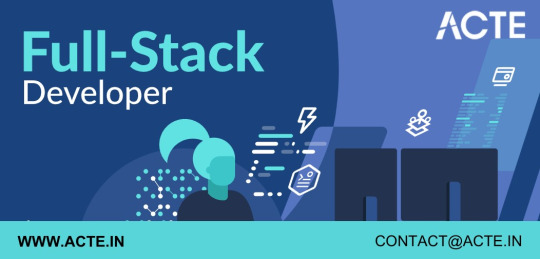
Front-End Development: Crafting the User Experience
When you visit a website or use a web application, the first thing that captures your attention is its visual presentation and user interface. Front-end development becomes important in this situation. Front-end developers are the creative minds behind the aesthetic aspects of websites, ensuring that the user experience is visually appealing and seamless.
Here's a closer look at the key components of front-end development:
User Interface Creation: Front-end developers are responsible for crafting the user interface (UI), which includes designing layouts, buttons, menus, and all the interactive elements that users see and interact with.
HTML & CSS Mastery: Mastery of HyperText Markup Language (HTML) and Cascading Style Sheets (CSS) is crucial. HTML provides the structure for web content, while CSS adds style and formatting to make it visually appealing.
JavaScript Wizardry: JavaScript, the dynamic scripting language, is the backbone of front-end development. It enables developers to create interactive features, animations, and real-time updates, enhancing the user experience.
Frameworks Galore: Front-end development often involves using frameworks like React and Angular. These frameworks provide pre-built components and libraries that streamline development and ensure consistency.
Back-End Development: Powering the Engine
While front-end development focuses on the visible aspects, back-end development deals with what happens behind the scenes. Back-end developers are responsible for building the server, managing databases, and handling server-side logic. This is where the data and functionality of a website or application come together.
A closer look into the world of back-end development is provided here:
Server-Side Management: Back-end developers create and maintain the server, ensuring it can handle requests from users, process data, and serve up the required content.
Database Wizardry: Databases are the storehouses of information. Back-end developers work with databases to organize and manage data efficiently. They use languages like SQL to query and manipulate data.
Server Frameworks: Various server-side frameworks, such as Node.js and Django, are used to streamline the development process. These frameworks provide tools and structure for building robust back-end systems.
Security and Performance: Back-end developers are tasked with implementing security measures and optimizing server performance to ensure data integrity and a smooth user experience.
Full-Stack Proficiency: The Complete Package
Full-stack developers are the ultimate all-rounders of web development. They possess an in-depth understanding of both front-end and back-end development, making them highly versatile and capable of handling every aspect of a project. Their unique skill set allows them to work on end-to-end solutions and tackle complex projects with ease.
Here's what sets full-stack developers apart:
Holistic Expertise: Full-stack developers have a holistic understanding of the entire web development process, from conceptualization and UI/UX design to database management and server-side logic.
Versatility: Their ability to work on both the client-side (front-end) and server-side (back-end) gives them the flexibility to contribute to various phases of a project.
Problem Solving: Full-stack developers excel at problem-solving. They can troubleshoot issues, debug code, and ensure the seamless functioning of web applications.
High Demand: In today's tech-driven world, full-stack developers are in high demand. Their ability to handle diverse tasks and contribute to multiple areas of a project makes them invaluable assets to companies.
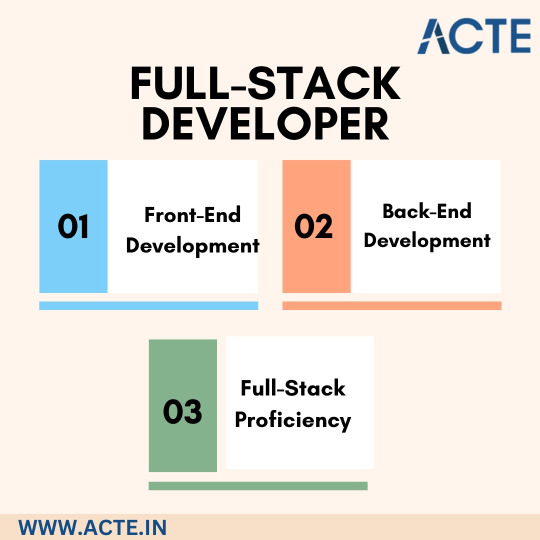
If you aspire to become a proficient full-stack developer, there's no better place to start your journey than ACTE Technologies. Renowned for its comprehensive full-stack development courses, ACTE Technologies equips aspiring developers with the knowledge and hands-on experience needed to master both front-end and back-end development.
In conclusion, full-stack development is a dynamic and highly rewarding field that demands expertise in both front-end and back-end development. Full-stack developers are the architects of complete web solutions, and their skills are in constant demand. So, if you're ready to embark on a thrilling journey of mastering this versatile skill set, ACTE Technologies is your trusted partner on the path to success.
2 notes
·
View notes
Text
youtube
Looking For A Full Stack Development Service Offered by Connect Infosoft Tech Pvt. Ltd.
Are you looking for a full stack developer service to take your business to the next level?
Connect Infosoft specializes in full stack development, offering services that help businesses meet their goals and move forward. We provide professional, high-quality full stack development services that are tailored to meet the unique needs of your business.
The team at Connect Infosoft Technologies Pvt. Ltd has 23+ years of experience in mobile app development. Our team of experienced Full Stack Developers is adept at creating custom software solutions that meet the unique requirements of your business.
With Full Stack Development Service, businesses can create highly customized, powerful applications that will meet their specific needs. Furthermore, a full stack development service offers the expertise and resources necessary to ensure that any project is delivered on time and within budget. Ultimately, full stack development services provide businesses with the means to innovate and stay competitive in an ever-changing market.
The Benefits of Hiring a Full Stack Developer: • Versatility. • Efficiency. • Expertise in multiple languages. • E-Commerce Development.
Some of the Full Stack Development services offered by Connect Infosoft include: • Custom Web Development. • E-commerce Solution. • API Integrations. • Mobile App Development. • UI/UX Design.
Kindly pen us with your exact requirements at [email protected] and we will give you our best and accurate quote as quickly as possible.
#LookingforFullStack developer#FullStackDevelopmentService#LookingforFullStack development#FrontEndDeveloper#BackEndDeveloper#FrontEndDevelopmentService#BackEndDevelopmentService#WebDesigningCompany#ConnectInfosoft#WebDevelopmentCompany#Facebook#Pintrest#Software#Trending#ViralVideo#Reel#Instagram#USA#India#Youtube
2 notes
·
View notes
Text

Crack the Code- Best MEAN Stack Course for Future Developers | Sensation Solutions
Unlock the secrets of web development with our best MERN Stack course, hailed as the best choice for aspiring developers. Crack the code to becoming a full-stack MERN developer with our comprehensive training. Dive into real-world projects, gain hands-on experience, and shape your future. Join Sensation Solutions for an immersive learning journey toward MERN stack mastery.
#Best MERN stack course#MERN Stack Course in Chandigarh & Mohali#full stack mern developer course#best full stack web development#advanced web designing course#best MEAN Stack course
1 note
·
View note
Text
While we’re at it, can we please bring back public Internet forums for software developers that isn’t Stack Overflow (which isn’t even that useful nowadays because half of the answers are toxic)? Part of the reason so many of us have turned to ChatGPT as a resource is because the internet has become so sterilized and ad-heavy that it makes searching for viable solutions next to impossible.
I know so many people that don’t want to rely on AI for development assistance, however the oversaturated nature of the internet means that web crawlers come out to top in terms of searching for references.
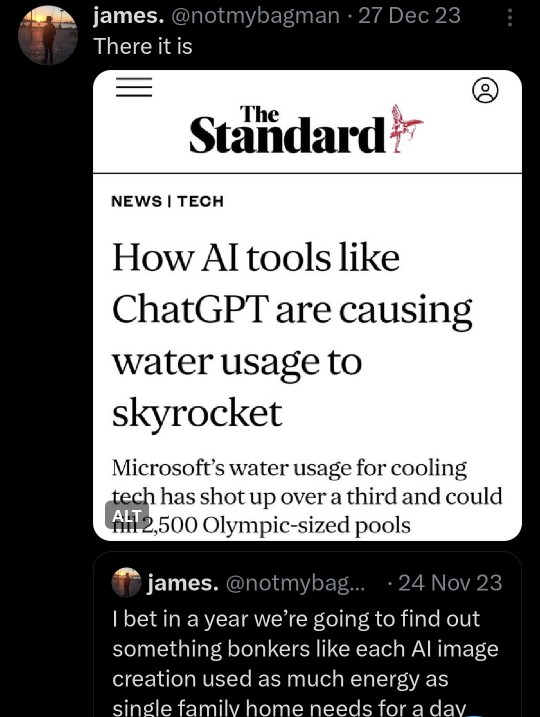
121K notes
·
View notes
Text
Exploring the Key Elements Behind a Successful Ecommerce Website Solution in UAE

Starting an eCommerce business in today's fast-moving UAE digital economy means far more than just putting a store online-you have to build a smooth, fast, and local experience that speaks to customers. Whether you're an established retailer in Dubai or a fresh startup in Abu Dhabi, choosing the right UAE eCommerce solution can give your company the push it needs to grow.
What really makes an eCommerce platform stand out in the UAE?
Success doesn't come from tech alone; it mixes clear strategy, easy design, dependable infrastructure, and respect for local customs.
In the sections below, we list the must-have ingredients for a website that clicks with shoppers in the Emirates.
Before you write a single line of code, spend some time learning the local digital playground:
Quick Digital Take-Up: With the web reaching almost every phone in the country, UAE shoppers jump online daily, eager to test fresh ideas.
Mobile-First Behavior: Since most people browse on smartphones, a responsive site isn-t a nice extra-it's the rule.
Multilingual & Multicultural Market: English and Arabic both matter; add both to your front end and watch your audience grow overnight.
Cash-on-Delivery Preference: Digital wallets are rising, yet many buyers outside the big cities still trust COD, so keep that option front and center.
The finest e-commerce site for UAE shoppers respects local customs and delivers what they expect:
1. Localized UX and UI Design
Culture and language shape every click and scroll. Your store should look like it was built for Emirates residents, not imported from abroad.
Arabic & English Toggle: Let shoppers switch languages with one tap. Test RTL pages carefully or hidden layout breaks will confuse buyers.
Visual Aesthetics: Clean, elegant photos that echo local style build trust.
User-Friendly Navigation: Product search, checkout, and returns should follow a clear, easy path.
Local Trust Indicators: Feature UAE customer reviews, list delivery partners, and show local support numbers.
2. Mobile-First Development Approach
Mobiles drive most online shopping in the UAE. Plan for small screens from the start or you'll frustrate the majority of your audience.
Progressive Web Apps (PWAs): Give users app-like speed and soothing scroll without a store download.
Fast Load Times: Compress images, set caching, and pick hosting that stands up to noon traffic.
Touch-Friendly Interfaces: Buttons, sliders, and forms must respond to a finger tap, not a cursor hover.
3. Strong, Scalable Tech Stack
Beneath that clean storefront, reliable code and dependable servers do the real work. The right back-end platform lets your business grow smoothly, with no annoying hiccups.
Pick a system that matches your budget and goals-whether its Magento, Shopify, WooCommerce, or a small custom build.
Secure Hosting with Local or CDN Support
Put servers near the UAE or use a fast content network so pages load in a blink and lag disappears.
Flexible CMS Integration
Let staff swap photos, write new posts, or tweak menus without bugging a programmer each time.
Make sure these tools sit well on the platform:
Stock control
ERP and CRM suites
Local payment and delivery APIs
Secure and Wide-Paying Gateways
A solid UAE store takes many cards and stays PCI cool:
Local payment gateways
Back brands like PayTabs, Telr, or Network International.
Digital wallets
Throughout the UAE, most customers say Apple Pay, Samsung Pay, and STC Pay make paying easy and safe.
Installment plans
When a bill feels heavy, Tabby or Tamara chop it into tiny monthly pieces so your budget stays on track.
Fraud shields
Every purchase is backed by SSL locks, fast one-time passwords, and alert software that watches for anything odd.
Advanced Product Search and Filtering
Today, online buyers want search results as fast and spot-on as Amazons.
Your site should serve:
Smart Filters
Narrow options by price, brand, rating, and more.
Auto-Suggest Search Bar
Help shoppers find items with as few taps as possible.
Search Personalization
Hint at products based on past views, current location, or UAE trends.
When buyers locate what they want effortlessly, conversion rates climb.
7. Localized Logistics and Fulfilment Strategy:
Shoppers in the UAE demand speedy service: Free, fast, and flexible delivery options drive sales.
Same-Day or Next-Day Delivery: This is a must-have in Dubai, Abu Dhabi, and Sharjah.
Flexible Return Policies: A quick seven- or fourteen-day returns window tells shoppers you believe in them.
Real-Time Tracking: Let customers see live order updates via SMS, WhatsApp, or in-app alerts the second anything changes.
Integration with Local Couriers: Work with Aramex, Fetchr, Quiqup, or trusted local riders so every package arrives on schedule.
8. SEO and Performance Optimization
Great products don't matter if your website stays buried in search results.
Well-tuned hype-free UAE ecommerce ranks where it needs to:
On-Page SEO: Fit H1s, H2s, product tags, meta copy, and schema speak in tune.
Arabic SEO: Plant keywords in Arabic plus English so no shopper feels left out.
Local SEO: Claim your Google My Business page and craft area-focused landing spots.
Speed Optimization: Quick-loading pages keep people on-site and lift your search ranking.
Image & Video Compression: Pictures and clips look great yet shrink so they don't stall the site.
Marketing Integrations:
Built-in tools let you speak to UAE shoppers, win their trust, and pull them back again.
Email marketing automation. Send friendly nudges-abandoned-cart reminders, tailored product tips, or quick live updates-so customers feel looked after, not bombarded.
Social commerce integration: Attach your shop to Instagram Shops, TikTok, and Facebook so casual scrolling turns into fast buying.
UAE-specific campaigns: Plan your Ramadan offers, drop fun National Day goodies, and outline Dubai Shopping Festival bundles today. Post tiny test ads several weeks ahead; the early lead gives you room to cut costs and spot the busiest hours.
Loyalty programs really count: Hand returning shoppers points they can trade for discounts, surprise gifts, or a behind-the-scenes day.
Data analytics and conversion tracking: Measure every click and cart, then fine-tune your strategy for higher sales.
The numbers show what soars, what flops, and where you need to look next.
Your e-commerce platform should link with:
Google Analytics and GA4.
Conversion funnels and heat maps: Spot where shoppers drop out.
User behavior insights: See how UAE visitors scroll, click, and search.
Live metrics let you tweak ads, copy, and design every day.
11. Play by UAE Laws and Keep Buyers Safe:
The UAE watches online shops closely to protect shoppers.
Place Terms and Conditions plus Returns where buyers can read them without searching.
List prices that include VAT so people see the total before checkout.
Say what data you collect and give customers the choice to agree.
A .ae web address and local servers reassure buyers in the Emirates.
12. Keep Your Store Fresh After Launch
An impressive store doesn't just launch; it keeps getting better.
Fix bugs quickly, monitor uptime, and listen to customer feedback.
Add new products, fresh banners, and holiday promos on a regular schedule.
Customer Support: Live chat, WhatsApp, and friendly AI bots are now normal.
Regular Backups and Security Patches
Picking a seasoned UAE ecommerce developer cuts post-launch stress and keeps you ahead of rivals.
Final Thoughts: Build a UAE Ecommerce Site That Succeeds
A winning UAE store loads fast, works perfectly on phones, speaks multiple languages, and feels local. It blends sleek design, solid hosting, safe payments, and region-specific tools that match buyers expectations.
Even the tiniest choice counts, whether you pick a payment partner or tweak the pictures on your Ramadan landing page.
Ready to launch a brand-new e-commerce site or give your old one a refresh in the UAE?
Whether you start from zero or polish what you already have, WDCS Technology builds all-in-one, UAE-focused online shops. We design mobile-first pages, set up fast payment links, and write local SEO so your brand stands out.
Work with us and turn casual browsers into loyal shoppers all across the Emirates.
#ecommercedevelopmentuae#technology#e commerce website solution#hire ecommerce developers#blockchain services
0 notes
Text
How Poscig Technologies Builds Fast, Secure, and Scalable Websites for Any Business

In the digital age, a website is more than just a business card it’s the foundation of your online presence. But for it to truly deliver results, it must be fast, secure, and scalable. This is where expert-level web development services come into play.
At Poscig Technologies, we go beyond aesthetics. As a leading web development company in Pune, India, we help businesses build performance-driven websites that are built to convert, scale, and protect.
Here’s how we ensure our clients stay ahead in the digital game.
Why Website Speed Matters?
Website visitors today expect lightning-fast experiences. Research shows that a 1-second delay in page load time can cut conversions by 7%, and over half of users abandon sites that take more than 3 seconds to load.
Speed also plays a major role in Google’s Core Web Vitals a key SEO ranking factor.
At Poscig Technologies, our web development services include:
Writing clean, minimal, and SEO-friendly code
Image compression techniques to reduce load time
Integration of global Content Delivery Networks (CDNs)
This ensures every website we build loads quickly, ranks well, and keeps users engaged.
Building Secure Websites
In today’s threat landscape, security isn’t optional — it’s critical. As a trusted provider of web development services in Pune, India, we embed security into every layer of your website’s architecture.
Here’s what we implement:
SSL certificates for secure data encryption
Secure frameworks like Laravel and Next.js
Regular vulnerability scans and code audits
Role-based access controls and authentication systems
Our goal? To ensure your business is protected from data breaches, phishing, and malware.

Scalable Architecture for Future Growth
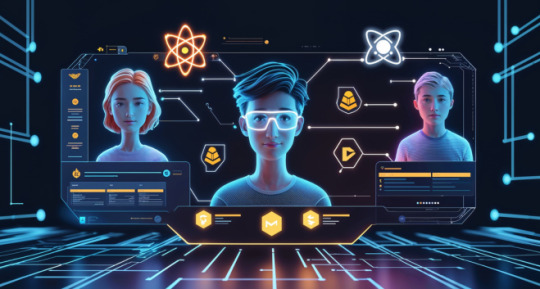
As your business grows, so should your website — without the need to rebuild it from scratch.
At Poscig Technologies, we specialize in scalable web development services. Our approach includes:
Modular and component-based coding
Optimized database structures
Cloud-based deployments using AWS, DigitalOcean, and more
Tech Stack and Tools That Power Our Success
To deliver top-tier solutions, we rely on the most modern and secure tools available:
Frontend: React, Next.js, Vue.js
Backend: Laravel, Node.js
Deployment Platforms: AWS, DigitalOcean, Vercel
DevOps: CI/CD pipelines for smooth updates and no downtime
This stack allows us to offer web development services that are not just high-performing, but also easy to maintain and expand.

Why Businesses Choose Poscig Technologies

Working with a best design company like Poscig Technologies means getting more than just a website — you get a digital platform built to grow and evolve with your business.
Faster websites increase engagement and drive conversions
Secure platforms reduce risk and build trust
Scalable solutions future-proof your online presence
Conclusion
In a world where digital expectations are constantly rising, having a visually attractive website is just the beginning. The real value lies in building a website that is fast, secure, and scalable — and that’s exactly what we do at Poscig Technologies.
If you’re looking for web development services in Pune, India, and want to work with a best design company that understands performance, security, and growth — we’re here to help.

#software development company in india#top software development companies#ai ml development company#business intelligence services#mobile app development company in pune#web development company in pune#cyber security services in pune#staff augmentation company in pune#website development company in pune##android app development company#cyber security management services#wordpress website development services#custom software development services
0 notes
Text
Hire Remote Developers with SMT Labs IT Staff Augmentation
In today's fast-paced digital world, growing your tech team quickly and effectively can make all the difference. Whether you're a startup looking to scale fast or an enterprise wanting to fill skill gaps, IT staff augmentation offers a flexible, cost-effective solution. And when it comes to finding top-tier remote talent, SMT Labs delivers unmatched value. Here's how.
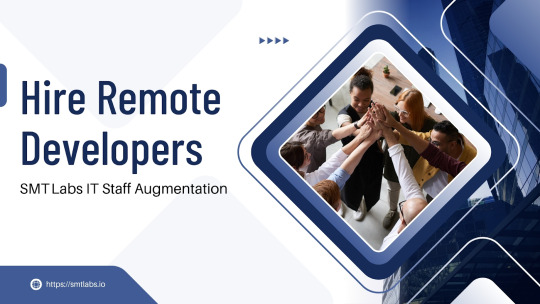
What Is IT Staff Augmentation—and Why You Need It
IT staff augmentation means integrating external developers into your team to handle specific projects or skill gaps without the overhead of full-time hires. Compared to traditional hiring or long-term outsourcing, it offers:
Flexibility – Easily scale your team up or down based on project needs
Speed – Quickly onboard experienced developers without months‑long hiring cycles
Cost‑efficiency – No need to pay for idle capacity, office space, or benefits
Specialized expertise – Plug in niche skills—from iOS to React Native, backend to DevOps
Pretty compelling, right? Now, let's talk about SMT Labs and why their staff augmentation service stands out.
SMT Labs: Your Remote Development Partner
Based in Indore, India, SMT Labs has been delivering web and mobile solutions since 2017. They’ve built a reputation with global clients—especially in the USA—for high-quality development services, including robust staff augmentation offerings.
Highlights of SMT Labs’ Staff Augmentation
Dedicated remote developers—From part-time to full-time, as per your project’s lifecycle .
Flexible engagement models—Need 40–80 hours/month? Or a full 160‑hour monthly commitment? They’ve got you covered.
Rich technology stack—iOS, Android, Flutter, React Native, Node.js, PHP, Python, AI/ML… you name it, they support it.
100% replacement guarantee—If a developer doesn’t fit, SMT Labs will replace them with no hassle.
IP & NDA protection—Critical for any remote work engagement .
Time‑zone flexibility—Seamless overlap with your operational hours.
Transparent reporting—Daily, weekly, or monthly progress updates and code delivery.
Specialties: Hire Software Developers On‑Demand
Whether you need React Native developers, iOS/Android/mobile app experts, or a full-stack/backend team, SMT Labs has you covered:
Mobile App Developers
iOS & Android (native) – Swift, Objective-C, Kotlin, Java
Cross-platform – React Native, Flutter
Frontend Web Developers
React.js, Angular, Vue.js, Bootstrap, HTML/CSS
Backend & Full‑Stack Engineers
Node.js, Python, PHP, Laravel, MySQL, MongoDB, AWS, Azure
AI/ML, Data & DevOps
From machine learning models to cloud automation
Plus, they provide QA engineers, project managers, DevOps, cloud specialists, and more.
Top Benefits of Choosing SMT Labs
Let’s break down why hiring remote developers through SMT Labs can transform your project's trajectory:
1. Speed & Agility
No waiting months for full-time hires. Get vetted, ready-to-start developers within days.
2. Cost Savings
Access skilled engineers in India’s competitive talent market—without sacrificing quality.
3. Technical Depth
Their team spans a wide tech stack—from mobile and web to AI and cloud—ensuring you get the right expertise for your project.
4. Scalability
Easily adjust resource levels—scale up when deadlines are tight, scale down post-launch.
5. Risk Mitigation
With the replacement guarantee and strong NDAs, your project stays smooth and secure.
6. Quality & Communication
SMT Labs is transparent, agile, and focused on consistent delivery backed by years of global project work.
How It Works
The process is simple and client-focused:
Requirement call – You outline your needs and priorities.
Talent shortlist – SMT Labs screens and suggests best-fit profiles.
You interview – Pick the developer(s) who fit your team style.
Onboard & start – They assist with setup and begin work under your management.
Enjoy daily/weekly code delivery and transparent communication from your remote team.
Ideal Use Cases
Replacing or supplementing in-house dev teams
Building an MVP or scaling a product rapidly
Adding niche skillsets (e.g., React Native, AI/ML)
Needing project management, QA, DevOps, or cloud skills
Looking to cut cost without compromising quality
Basically: hire software developers, hire remote developers, hire programmer, hire mobile app developers, hire iOS or React Native developers—all with a flexible, risk‑mitigated model.
How to Get Started with SMT Labs
Step 1: Go to their “Hire Developers” page and fill in your requirements.
Step 2: They'll arrange a call to align on your goals.
Step 3: Review profiles and interview.
Step 4: Onboard your dedicated remote developers and begin delivering value.
You’ll enjoy the flexibility to start, pause, or scale engagement easily—perfect for agile teams looking to evolve quickly.
Final Thoughts
If your project requires top-tier talent—whether you're looking to hire software developer, hire mobile app experts, or hire React Native developers—and you need them fast, cost-effectively, and securely, SMT Labs is your ideal partner.
With their deep technical expertise, flexible talent model, and commitment to quality and transparency, SMT Labs’ IT staff augmentation service helps you build strong, scalable teams in weeks—not months.
Ready to hire remote developers? Connect with SMT Labs now to start scaling smarter and accelerating your roadmap.
Contact SMT Labs Today Reach out to their team via the “Hire Developers” page.
#staffaugmentation#hire software developers#hire remote developers#hire software programmer#hiring a software developer#hire mobile app developers#hire ios app developer#hire React Native developer#it staff augmentation#it staff augmentation services#it staff augmentation company#it staff augmentation services in usa
0 notes
Text
The Future of Full Stack Development: Envisioning Cutting-edge Trends and Innovations
In the rapidly evolving digital era, the concept of full stack development has emerged as a critical component for modern businesses. Embracing full stack development means embracing the ability to handle both frontend and backend development tasks, effortlessly bridging the gap between different layers of technology. By having a holistic understanding of all aspects of software development, full stack developers hold the key to unlocking innovation, efficiency, and adaptability in the tech industry.
Staying ahead of the curve is imperative for any developer, and full stack development plays a vital role in enabling professionals to do just that. In this article, we will explore the realm of full stack development, its evolution over time, and the cutting-edge trends and innovations that are shaping its future.

II. Understanding Full Stack Development
Defining full stack development and its evolution over time
Full stack development refers to the practice of handling both frontend and backend development tasks, making developers proficient in multiple technologies. While the term "full stack" was initially coined to describe web development, its scope has expanded to encompass a broader variety of technologies and platforms, including mobile applications.
Throughout its evolution, full stack development has transformed from being focused on traditional web development stacks to embracing modern and versatile frameworks. This shift has allowed developers to have a more comprehensive understanding of the entire software development process.
Importance of full stack developers in today's tech industry
The demand for full stack developers has soared in recent years, primarily due to their ability to handle various development tasks efficiently. Full stack developers possess a unique skill set that allows them to contribute to different stages of the development lifecycle, making them highly sought after by organizations looking to streamline their processes.
By being capable of working on both the frontend and backend, full stack developers bring synergy to teams, facilitating seamless collaboration and reducing the need for heavy dependencies on specialized roles. Their versatility empowers organizations to innovate rapidly and respond effectively to changing market demands.
III. The Evolution of Full Stack Development
Early days: Traditional web development stacks
In the early days of full stack development, traditional web development stacks like LAMP (Linux, Apache, MySQL, PHP) and WAMP (Windows, Apache, MySQL, PHP) dominated the scene. These stacks provided developers with the foundations to build dynamic and interactive websites, integrating various frontend elements with backend functionalities.
Shifting to modern stacks: MEAN, MERN, and more
As web technologies evolved, modern full stack development stacks like MEAN (MongoDB, Express.js, Angular, Node.js) and MERN (MongoDB, Express.js, React, Node.js) emerged. These stacks capitalized on the power of JavaScript to provide developers with a unified language for both frontend and backend development. These modern stacks enable rapid development and enhance code reusability and maintainability.
The rise of versatile frameworks and libraries
The continuous innovation in the tech industry has given rise to versatile frameworks and libraries that augment the capabilities of full stack developers. Frameworks like Laravel, Ruby on Rails, and Django simplify backend development, while frontend frameworks like React, Angular, and Vue.js provide efficient solutions for creating dynamic user interfaces. These frameworks, combined with powerful libraries like Redux and Bootstrap, empower full stack developers to create robust, user-friendly, and visually appealing applications.
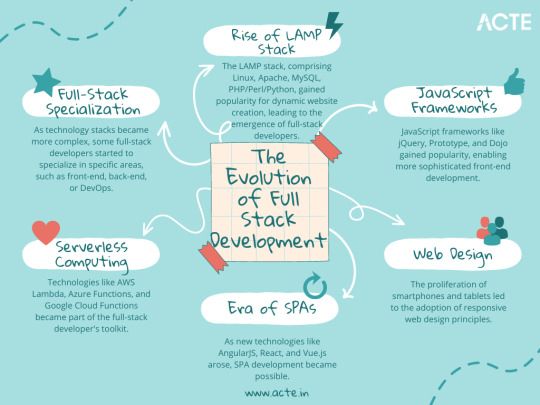
IV. Key Technologies Shaping the Future of Full Stack Development
Artificial Intelligence and Machine Learning integration
Artificial Intelligence (AI) and Machine Learning (ML) are revolutionizing full stack development by enabling developers to create intelligent and data-driven applications. Integration of AI and ML technologies into full stack development empowers applications to analyze vast amounts of data, make informed decisions, and provide personalized experiences to users.
Blockchain technology and its impact on full stack development
Blockchain technology is another key innovation that is transforming the landscape of full stack development. Its decentralized and immutable nature brings enhanced security, transparency, and traceability to applications. Full stack developers are leveraging blockchain to build secure and trustless applications for various industries, such as finance, supply chain, and healthcare.
Augmented Reality/Virtual Reality and its potential applications
Augmented Reality (AR) and Virtual Reality (VR) are emerging technologies that hold immense potential for full stack development. These technologies offer unique opportunities to create immersive and engaging user experiences. Full stack developers can harness AR and VR to build applications for gaming, training simulations, virtual tours, and other interactive experiences.
V. Exploring Advanced Front-end Development
Progressive Web Apps and their advantages
Progressive Web Apps (PWAs) are a cutting-edge advancement in full stack development that combines the best features of web and mobile applications. PWAs offer fast and reliable performance, offline capabilities, and push notifications, providing users with an app-like experience directly from their browsers. Full stack developers can leverage frameworks like React and Angular to build PWAs that support cross-platform compatibility and deliver seamless user experiences.
The role of JavaScript frameworks: React, Angular, Vue.js
React, Angular, and Vue.js are a few examples of JavaScript frameworks that have completely changed front-end development.These frameworks provide developers with the tools and components necessary to build interactive and responsive user interfaces. Full stack developers proficient in these frameworks can create dynamic web applications and enhance user experiences with ease.
WebAssembly: Unlocking high-performance web applications
WebAssembly (WASM) is an innovative technology that allows full stack developers to run high-performance applications directly in the browser. With WebAssembly, developers can compile languages like C, C++, and Rust into a binary format that can execute at near-native speeds. This capability enhances the performance and versatility of web applications, opening up new possibilities for full stack development.
VI. Innovative Back-end Developments
Serverless architecture and its benefits
Serverless architecture is transforming the way backend development is approached. With serverless computing, full stack developers can focus more on the core functionality of their applications, without the need to manage the infrastructure. Serverless platforms like AWS Lambda and Azure Functions provide scalability, cost efficiency, and ease of deployment, allowing developers to build and deploy applications more rapidly.
Microservices: Enhancing scalability and flexibility
Microservices architecture is gaining popularity in full stack development due to its ability to enhance scalability and flexibility. By breaking down applications into smaller, modular services, full stack developers can independently develop, test, deploy, and scale different components of the application. Microservices enable teams to collaborate more effectively, improve fault tolerance, and achieve faster time-to-market.
Containerization: Docker and Kubernetes revolution
Containerization has revolutionized the deployment and management of applications. Docker, combined with orchestration tools like Kubernetes, allows full stack developers to package applications along with their dependencies into lightweight and portable containers. This approach enables seamless deployment across different environments and simplifies scaling and maintenance, making it a preferred choice for modern full stack development.
VII. The Convergence of DevOps and Full Stack Development
Understanding the collaboration between developers and operations
DevOps has emerged as a crucial discipline that emphasizes seamless collaboration between development and operations teams. In the context of full stack development, this collaboration becomes even more critical, as developers are responsible for both frontend and backend operations. By adopting DevOps principles, full stack developers can streamline processes, accelerate delivery, and maintain a high level of quality in their applications.
Continuous Integration and Continuous Delivery (CI/CD) pipelines
Continuous Integration (CI) and Continuous Delivery (CD) pipelines are fundamental practices for full stack development teams. CI/CD pipelines automate the process of integrating code changes, running tests, and delivering applications to production environments. By embracing CI/CD pipelines, full stack developers can ensure faster, more frequent releases while maintaining the stability and quality of their applications.
Infrastructure as Code (IaC) practices
Infrastructure as Code (IaC) is a key practice that enables full stack developers to manage infrastructure programmatically, treating it as code. Using tools like Terraform and CloudFormation, developers can define and provision infrastructure resources declaratively. This approach enhances scalability, reproducibility, and consistency, and reduces the chances of manual errors, making infrastructure management more efficient and reliable.
VIII. The Impact of Cloud Computing on Full Stack Development
Cloud-native development: Advantages and challenges
Cloud computing has transformed the landscape of full stack development. Full stack developers can leverage cloud platforms like AWS, Azure, and Google Cloud to build scalable, reliable, and cost-effective applications. Cloud-native development allows developers to take advantage of cloud services, such as storage, databases, and machine learning, without the need for extensive infrastructure management. However, challenges related to security, vendor lock-in, and latency must be carefully addressed when adopting cloud-native approaches.
Leveraging Platform-as-a-Service (PaaS) solutions
Platform-as-a-Service (PaaS) solutions offer full stack developers a simplified and streamlined environment to develop, deploy, and manage applications. PaaS platforms, like Heroku, Cloud Foundry, and Google App Engine, abstract away the underlying infrastructure, allowing developers to focus solely on application logic. PaaS solutions accelerate development cycles, remove the burden of infrastructure management, and enable developers to iterate quickly.
Serverless computing and its implications
Serverless computing, offered by cloud providers such as AWS Lambda and Azure Functions, has gained significant attention in recent years. With serverless computing, full stack developers can focus on writing small, event-driven functions that automatically scale based on demand. This approach significantly reduces operational overhead, improves resource utilization, and allows developers to build highly scalable and cost-efficient applications.
IX. Full Stack Development for Mobile Applications
Native vs. Cross-platform development
When it comes to mobile application development, full stack developers face the choice between native and cross-platform development. Native development involves building applications specifically for a particular platform, such as iOS or Android, using platform-specific programming languages. Cross-platform development, on the other hand, allows developers to write code once and deploy it on multiple platforms. While native development offers maximum performance and access to platform-specific features, cross-platform development provides greater code reusability and faster development cycles.
Mobile frameworks: React Native and Flutter
React Native and Flutter are two popular mobile frameworks that have gained significant traction in the full stack development community. React Native, based on JavaScript, and Flutter, based on Dart, provide the ability to build high-quality native mobile applications using a single codebase. These frameworks offer reusable components, hot reloading, and a rich ecosystem of libraries and tools, empowering full stack developers to create stunning and performant mobile apps rapidly.
Mobile web development: Challenges and opportunities
Mobile web development enables full stack developers to create web applications optimized for mobile devices. While this approach provides the advantage of platform independence and ease of maintenance, it poses challenges like limited access to device features and potential performance limitations. However, leveraging responsive design, progressive enhancements, and caching mechanisms, full stack developers can overcome these challenges and deliver seamless mobile experiences through web applications.
X. The Future of User Experience (UX) in Full Stack Development
Voice User Interfaces (VUIs) and Natural Language Processing (NLP)
Voice User Interfaces (VUIs) and Natural Language Processing (NLP) are transforming the way users interact with applications. With advancements in technologies like Speech Recognition and Natural Language Understanding, full stack developers can build applications that respond to voice commands and understand natural language. By integrating VUIs and NLP, developers can provide intuitive, hands-free user experiences, enabling better accessibility and increased user engagement.
Augmented Reality (AR) and User Interface (UI) integration
Augmented Reality (AR) is reshaping the user experience landscape by overlaying virtual content onto the physical world. Full stack developers can fuse AR technology with user interfaces, creating interactive and immersive experiences. By integrating AR into applications, developers can enhance visualization, spatial awareness, and engagement, opening up new possibilities in areas such as gaming, retail, and education.
Intelligent chatbots and personalized user experiences
Intelligent chatbots powered by Artificial Intelligence (AI) are becoming increasingly prevalent in applications. Full stack developers can leverage AI technologies like Natural Language Processing and Machine Learning to create chatbots capable of understanding user intents and providing personalized responses. By incorporating chatbots into applications, developers can automate customer support, improve user interactions, and deliver tailored experiences at scale.
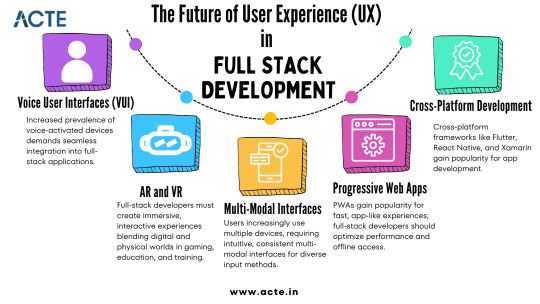
XI. Security Considerations in Full Stack Development
Protecting applications against data breaches and cyberattacks
The most important consideration in full stack development is security. Developers that work across the entire stack must be well-versed in secure coding techniques and have a solid grasp of typical vulnerabilities and attack vectors. Developers may safeguard apps against data breaches and cyberattacks, protecting user information and preserving the integrity of the systems they create, by integrating secure authentication mechanisms, input validation, encryption methods, and routine security audits.
Implementing secure coding practices
Secure coding practices are essential to mitigate security risks in full stack development. Developers must adhere to industry best practices, such as validating user inputs, using parameterized queries to prevent SQL injection, and employing access control mechanisms to ensure proper authorization. By following secure coding principles, full stack developers can minimize the likelihood of introducing vulnerabilities and maintain the confidentiality, integrity, and availability of applications.
Incorporating encryption and authentication mechanisms
Encryption and authentication mechanisms play a critical role in securing full stack applications. Full stack developers should implement encryption protocols like SSL/TLS to protect data transmission and storage. Additionally, robust authentication mechanisms, such as multi-factor authentication and OAuth, should be utilized to ensure that only authorized users can access sensitive resources. By incorporating these security measures, developers can fortify applications against unauthorized access and data breaches.
XII. Scaling Full Stack Applications for the Modern Era
Horizontal and vertical scaling: Pros and cons
Scaling is a fundamental aspect of full stack development to ensure applications can handle increased user demand. Full stack developers can choose between horizontal scaling, which involves adding more instances of servers to distribute the workload, and vertical scaling, which involves increasing the resources of existing servers. Horizontal scaling provides better fault tolerance and can handle rapid spikes in traffic, while vertical scaling offers better performance and reduced overhead. Choosing the appropriate scaling strategy depends on the unique requirements and architecture of the application.
Optimizing performance with caching and load balancing
Optimizing performance is crucial in full stack development. By implementing caching mechanisms, such as Content Delivery Networks (CDNs) and in-memory caching, full stack developers can minimize server response times and reduce the load on the backend infrastructure. Additionally, load balancing techniques distribute traffic across multiple servers, preventing overload and ensuring optimal performance. By leveraging caching and load balancing strategies, developers can improve scalability, reliability, and user experience.
Monitoring and error handling strategies
The vitality and stability of full stack applications depend on monitoring and error management. Full stack developers should use reliable monitoring tools that offer in-the-moment visibility into the performance, resource usage, and any problems of the application. Developers can proactively discover and address issues by utilizing logging, alerting, and automated error handling techniques, which reduces downtime and improves the user experience overall.
XIII. Learning Resources
Given that there is so much to learn and comprehend, staying current with the most recent full stack development trends and breakthroughs can be a challenging undertaking. Fortunately, there are many tools at their disposal to assist developers in keeping up with the most recent developments and technology. These sources include blogs, books, tutorials, and Full Stack Developer courses.

In conclusion, any software developer must stay current with the most recent trends and advances because full stack development is a field that is continuously changing in order to produce better, more effective solutions. We have examined some of the most recent full stack development trends and innovations in this blog, including low-code/no-code development, automation, artificial intelligence, open source platforms, cloud-based solutions, cross-platform development, containers, blockchain development, GraphQL, data-driven solutions, augmented reality, and virtual reality applications. There are several resources accessible for those who want to learn more about full stack development, including online courses, tutorials, books, and blogs.
6 notes
·
View notes
Text
Top React Native App Development Companies to Work With in 2025
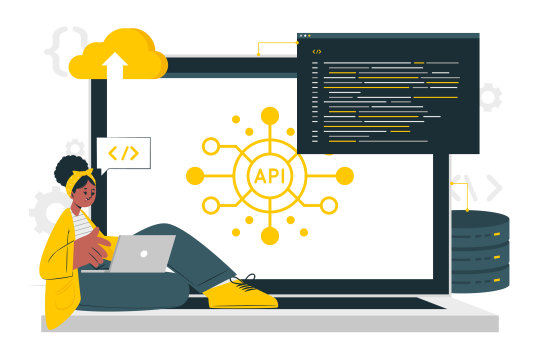
In today’s competitive digital world, businesses are constantly seeking ways to build fast, scalable, and cost-effective mobile apps. One solution that's leading the way is React Native app development. Known for its ability to create high-performing applications for both Android and iOS platforms using a single codebase, it has become the go-to framework for startups and enterprises alike.
The popularity of React Native app development stems from its flexible architecture, community support, and the ease it provides for integrating native modules. Whether you're launching a simple MVP or a feature-rich enterprise app, React Native simplifies the development process while ensuring a smooth user experience.
When it comes to Hybrid vs Native Apps, the debate continues—but React Native cleverly combines the best of both worlds. It allows developers to write once and deploy across platforms, reducing time-to-market and development costs significantly.
Moreover, if you’ve ever wondered, Which Mobile App Framework Suits Your Business – Flutter or React Native?, it's important to analyze your business goals, app complexity, and budget. While Flutter is growing in popularity, React Native offers better JavaScript support, larger community resources, and broader plugin availability.
A standout benefit of React Native app development is that it enables Cross platform development. This means fewer resources, faster testing, and easier maintenance—all while delivering native-like performance.
The Power of React Native in Modern App Development
React Native, backed by Facebook, uses JavaScript and React to build natively rendered apps. With features like hot-reloading, third-party plugin integration, and reusable components, it has become a favorite among developers and product teams.
An interesting trend is the rise of Detailed Tutorial on React Server Side, which showcases how server-side rendering (SSR) with React Native can improve load times, SEO performance, and user experience—especially for mobile web apps and hybrid solutions. Incorporating server-side rendering into your React Native app development process not only boosts performance but also helps in making applications more discoverable through search engines. Another key point to consider is scalability. React Native’s modular architecture and easy integration with native APIs make it ideal for businesses aiming for long-term growth and app flexibility.
Book an Appointment
Want to explore how React Native fits into your mobile strategy? Book an appointment with our React Native consultants today for a free demo and project roadmap.
Choosing the Right React Native App Development Partner
Choosing a trusted development partner can make or break your mobile strategy. The market is filled with numerous agencies and freelancers, but only a few offer proven expertise, full-stack capabilities, and tailored solutions.
That’s why we’ve curated a list of the Top 10 React Native App Development Companies that you can confidently collaborate with in 2025:
Toptal – Known for its elite pool of React Native developers.
MindInventory – Offers both React Native and backend services for full-stack development.
Appinventiv – Provides customized mobile solutions using React Native.
Netguru – Delivers quality UI/UX with React Native speed.
Simform – Offers agile development and enterprise-grade React Native apps.
GeekyAnts – Actively contributes to the React Native ecosystem.
Zco Corporation – Great for startups looking for cost-effective solutions.
WillowTree – Enterprise-level development with a design-first approach.
Fueled – Popular among funded startups.
Hidden Brains – Known for global delivery and scalable app solutions.
Partnering with these companies ensures your React Native app development process is seamless, strategic, and future-ready.
React Native vs Other Frameworks: A Practical Outlook
Let’s revisit the big question: Which Mobile App Framework Suits Your Business – Flutter or React Native?
While Flutter has its advantages like custom widgets and Dart-based programming, React Native still leads in terms of maturity, JavaScript ecosystem, and ready-to-use plugins. It's particularly ideal for businesses that already have web apps built with React.js.
React Native app development also offers easier integration with existing systems, especially if you’re planning a mobile-first transition from a traditional web-based system.
Additionally, businesses focused on scalability often leverage Cross platform development using React Native to maintain code consistency across devices and platforms. This not only accelerates deployment but also reduces ongoing maintenance overheads.
What’s New in React Native for 2025?
With every update, React Native evolves to offer more stability, performance, and developer tools. In 2025, the focus will shift further towards better support for Detailed Tutorial on React Server Side integration, accessibility improvements, and enhanced debugging tools.
Moreover, companies are investing in hybrid strategies due to growing confidence in the performance capabilities of React Native. The Hybrid vs Native Apps conversation is fading as businesses realize that hybrid frameworks like React Native can now deliver native-like speed, look, and feel. Still, if you're unsure, a good development company will help you decide the best fit based on your business requirements.
Final Thoughts
Whether you’re a startup or an enterprise, embracing React Native app development can significantly streamline your mobile strategy. It’s cost-effective, developer-friendly, and ideal for Cross platform development.
From enhancing your app’s performance using Detailed Tutorial on React Server Side to understanding the debate between Hybrid vs Native Apps, React Native continues to prove itself as a forward-looking solution. And when asking Which Mobile App Framework Suits Your Business – Flutter or React Native?, the answer increasingly favors React Native due to its maturity and community-driven growth.
When you're ready to transform your mobile app vision into reality, choosing from the Top 10 React Native App Development Companies can ensure your project is in expert hands.
So what are you waiting for? Your next big mobile success story begins with React Native app development.
0 notes
Text
From Tableau Extensions to Power BI Custom Visuals: Bridging the Gap
In the fast-paced world of business intelligence, customization plays a pivotal role in delivering actionable insights. Tableau and Power BI—two of the leading BI platforms—both support extensibility through custom components. Tableau offers Extensions that allow developers to enhance dashboards with external applications, while Power BI supports Custom Visuals that extend the visual capabilities beyond default chart types. When migrating from Tableau to Power BI, organizations often face a major question: how do we bridge the gap between Tableau Extensions and Power BI Custom Visuals?
Understanding the Landscape
Tableau Extensions are web-based applications that interact with dashboards using the Extensions API. They are ideal for integrating third-party tools, performing write-back capabilities, or adding tailored user experiences within Tableau dashboards.
On the other hand, Power BI Custom Visuals are open-source visual components built using TypeScript and D3.js or React. They are embedded within Power BI reports and serve to visualize data in innovative ways not available by default.
Though both platforms support custom development, their architectures and ecosystems are quite different. This creates a challenge when migrating, as Tableau Extensions cannot be simply ported into Power BI. A strategic, well-informed approach is essential.
Key Differences That Matter
Technology Stack: Tableau uses JavaScript and relies heavily on iframe-based web integration, whereas Power BI Custom Visuals require knowledge of TypeScript, D3, or React. This often means upskilling teams or outsourcing development during migration.
Integration Scope: Extensions in Tableau can pull or push data from external sources, while Power BI Custom Visuals are sandboxed with limited external data interaction. However, Power BI’s architecture emphasizes data security and controlled deployment through AppSource.
Deployment & Sharing: In Tableau, Extensions are embedded directly in dashboards with fewer restrictions. In Power BI, custom visuals must be certified to be listed in AppSource, or they need to be deployed through organizational visuals, requiring IT governance.
Bridging the Gap: A Strategic Approach
To ensure a smooth transition, the migration strategy should focus on business continuity and usability. The following steps can help organizations bridge the customization gap effectively:
Inventory Custom Components: Start by identifying all Tableau Extensions in use and mapping them to equivalent or similar Power BI visuals, either from AppSource or through custom development.
Leverage Power BI SDKs: Microsoft provides detailed documentation and sample projects to help developers build custom visuals. Utilizing these tools can speed up the conversion process.
Prioritize Based on Impact: Not every Tableau Extension may be critical. Focus on high-impact, business-critical extensions that are essential for decision-making.
Use AI-Powered Tools: Solutions like Pulse Convert (developed by OfficeSolution) accelerate the migration process, ensuring seamless translation of dashboards and visuals with up to 99% accuracy.
Train Your Team: Equip your analysts and developers with the necessary Power BI skills to maintain and evolve custom visuals post-migration.
The Future Is Interoperable
With the growing focus on interoperability and flexibility in BI, organizations must adopt a platform-agnostic mindset. Migrating from Tableau Extensions to Power BI Custom Visuals is not just a technical task—it’s a strategic opportunity to modernize your analytics environment.
For businesses looking to make this shift, OfficeSolution’s expert-led services and AI-powered tools provide the guidance and automation necessary for a seamless experience. Visit https://tableautopowerbimigration.com/ to learn more and begin your journey.
0 notes
Text
Elevate Your Business in Kerala: The Full Stack, AI, & E-commerce Edge from Trivandrum

Kerala, the “God’s Own Country,” is not just renowned for its serene backwaters and lush greenery; it’s rapidly emerging as a dynamic hub for technological innovation. Businesses across the state, from burgeoning startups to established enterprises, are increasingly recognizing the critical need for a robust digital presence. If you’re looking to not just compete but truly revolutionize your online strategy, embracing full-stack development, cutting-edge e-commerce solutions, and AI-driven customer engagement is key. And for that, Trivandrum is your go-to destination.
Why Full Stack is Your Foundation for Digital Excellence
In today’s complex digital landscape, a piecemeal approach to web development simply won’t cut it. You need a cohesive, end-to-end solution that handles everything from the server, database, and APIs (backend) to the user interface (frontend). This is where the expertise of a best full stack web development agency in Trivandrum, Kerala becomes invaluable.
A full-stack agency ensures seamless integration, optimized performance, and scalability across your entire digital ecosystem. They handle all layers of your application, from conceptualization to deployment and maintenance, providing a unified and efficient development process. This holistic approach means your web solution is not just functional but also robust, secure, and ready for future growth.
Unlocking Your Sales Potential with E-commerce Web and App Development
The retail landscape has irrevocably shifted online. To capture market share and serve a wider audience, a powerful e-commerce platform is non-negotiable. Whether you’re a local boutique or a large distributor, investing in top-tier eCommerce web development services in Kerala can transform your sales strategy.
These services go beyond just setting up an online store. They focus on creating intuitive user experiences, secure payment gateways, efficient inventory management, and robust analytics. Furthermore, with mobile commerce dominating online shopping, leveraging the best eCommerce app web development services in Kerala is crucial. A dedicated mobile app can significantly enhance customer engagement, simplify the shopping process, and provide a personalized experience, driving higher conversions and fostering customer loyalty.
The AI Advantage: Intelligent Chatbots for Superior Customer Engagement
In an age where instant gratification is king, customer support needs to be smarter, faster, and available 24/7. This is where AI-driven chatbots step in, revolutionizing how businesses interact with their clients. For businesses in Kerala seeking to elevate their customer service and streamline operations, partnering with an AI-driven chatbot development company in Trivandrum is a strategic move.
These intelligent chatbots can:
Provide instant support: Answering FAQs, guiding users through processes, and resolving common queries without human intervention.
Generate leads: Qualify potential customers by asking relevant questions and routing them to the right sales team.
Personalize experiences: Offer tailored recommendations and information based on user behavior and preferences.
Automate routine tasks: Freeing up your human agents to focus on more complex or sensitive customer issues.
Integrating an AI chatbot into your website or app enhances user experience, reduces operational costs, and ensures your business is always available to assist customers, even outside of business hours.
Your Path to Digital Transformation Starts in Trivandrum
The convergence of expert full-stack development, cutting-edge e-commerce solutions (both web and app), and transformative AI-driven chatbots offers a powerful combination for businesses aiming for digital dominance. Trivandrum, with its growing tech ecosystem and skilled talent pool, is home to agencies that specialize in these critical areas.
By choosing the right partner in Kerala, you’re not just building a website or an app; you’re investing in a comprehensive digital strategy designed for sustainable growth, enhanced customer engagement, and a competitive edge in the evolving market. Don’t just adapt to the future; create it with the right technology partners.
0 notes